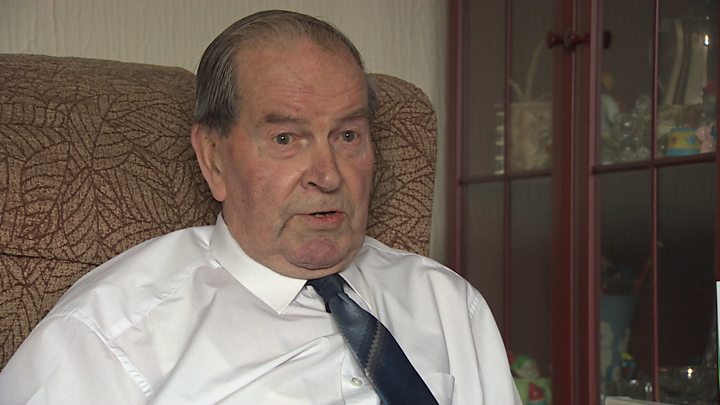[ad_1]

Media playback is unsupported on your device
Robert Pope was just seven when he was involved in the tragic events that took place in the Glen Cinema in Paisley 90 years ago.
The 97-year-old was at the Hogmanay matinee screening at which 71 children died.
The auditorium was packed with more than 600 kids when the screen went black and somebody shouted “fire!”, Mr Pope says.
“That’s what caused all the panic,” he says.
The alarm had been raised after smoke from a film canister was seen in the auditorium.
There was no fire but, as children panicked and rushed for the padlocked exits, many were trampled or crushed in the confusion.
Image copyright
Renfrewshire Council
The Glen Cinema was packed with more than 600 children for a Hogmanay performance
Seventy-one children died as a results of the events of 31 December 1929, including Mr Pope’s friend Willie Spiers, who had been sitting beside him in the cinema.
He died from injuries sustained in the panic.
Mr Pope says he survived because he did not move from his seat.
“I was out for the count,” he says. “I never knew nothing. People were squealing, shouting, bawling.”
Mr Pope remembers being roused by a fireman tapping him on the shoulder and telling him to run home to his mother.
Looking back, he says his “guardian angel” must have been protecting him that day.
Emily Brown is now 95
The only other survivor of that day, Emily Brown, is now 95. She was just five when she went to the cinema with her two sisters, aged three and 10, to watch the cowboy film Desperado Dude.
Emily told BBC Scotland there was a lot of panic when someone shouted “fire”. She says there was a crush at the doors and people were jumping from the balcony on to the children below.
She was saved when a fireman smashed a window and got her out. Emily was separated from her sisters but they also escaped. Some of her friends died.
“Everything stopped that day,” she says. “Most of the people in Paisley lost somebody. We were lucky, others weren’t.”
Image copyright
Renfrewshire Council
The Glen Cinema was on the High Street in Paisley
The disaster began as the film reached a crescendo.
According to filmmaker Paul Mothersole, who has studied the tragedy for 15 years, the film operator spotted a reel of nitrocellulose film which had begun to smoulder.
A later inquiry would conclude it was caused when the metal box containing the nitrate film had been placed on top of a battery in the projection room.
It is thought that the box was taken out and placed in a backroom where it sprang open and smoke started to enter the packed auditorium.
Mr Mothersole, who first interviewed survivors on the 75th anniversary, said it was an adult voice that shouted “fire!”.
The children panicked and ran towards the exits but the doors were locked.
Not only were they locked but they were padlocked from the outside to stop children sneaking into the cinema.
Image copyright
Renfrewshire Council
The Boys Brigade marched past the picture house at the funeral
Mr Mothersole describes hundreds of children crushing up against the exit doors as well as others who could not get down from the balconies and chose to jump from the upper floor.
“It was like a pressure cooker,” he says. “Nobody can get out of the exits and the people in the balconies cannot get down the stairs. It just gets worse and worse.”
Eventually a policeman managed to break the padlock to one of the doors but there was still a problem.
The doors opened inward and there were bodies piled behind them.
They had to force the door open to move the people piling up behind it.
“People were scrambling and climbing over the bodies to get out,” Mr Mothersole says.
Image copyright
KIERAN CHAMBERS PHOTOGRAPHY
The cinema was full because it was Hogmanay.
At the time, it was a major Scottish tradition to clean the house ready for the new year.
“All the mothers kicked all the kids out so they could get the houses ready,” Mr Mothersole said.
The audience was all children and the ages ranged from babies, brought along by their older siblings, to about 14.
Image copyright
KIERAN CHAMBERS PHOTOGRAPHY
Survivors Robert Pope and Emily Brown attended a memorial ceremony earlier this month
Many families lost more than one child.
As the tragedy unfolded, fathers were let out of the factories to help out and the tram cars used to ferry people to hospital.
In the wake of the disaster, the Cinematograph Act of 1909 was amended to make sure cinemas would have more exits, and that escape doors were to be fitted with push bars that opened outwards.
The building that housed the Glen Cinema still stands, and currently houses a furniture store
The building that housed the Glen Cinema still stands, and currently houses a furniture store.
Mr Mothersole has made a documentary film about the disaster.
He says more people should know the worst cinema disaster in British history.
[ad_2]
Source link

